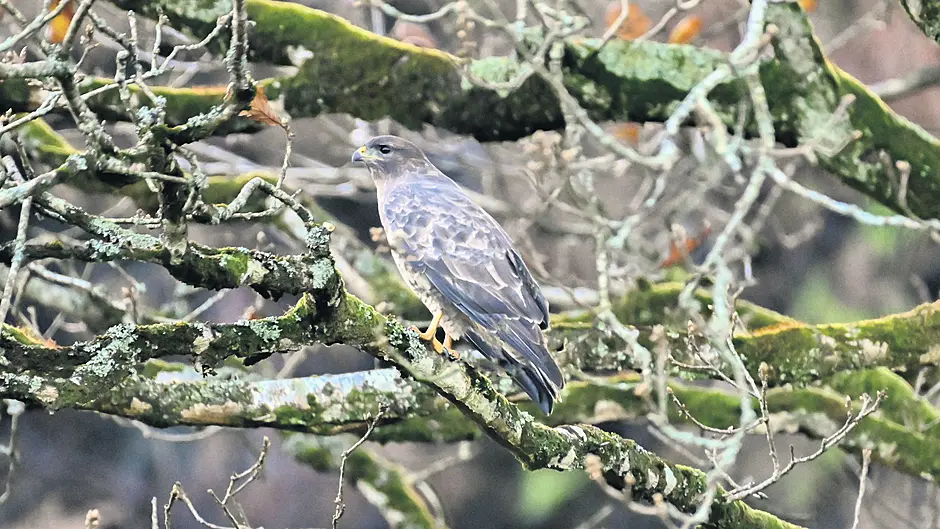BY ANN HAIGH
I WAS driving to the beach last week when there was a loud squawk of excitement from my son in the back seat. ‘There’s an eagle, a huge eagle,’ he exclaimed. While he is certainly knowledgeable about wildlife for a six year old, his identification skills should still not be trusted. When it was safe to do so, we pulled in and went back for a closer look.
The bird in question was sitting proud and stern in a bare tree and while it was certainly not an eagle, the Common Buzzard we saw perched there was a majestic sight none-the-less.
Smaller than eagles
Common Buzzards are raptors, sporting their group’s characteristic sharp and hooked beak and with equally sharp talons on their feet, they are very well adapted for their carnivorous diet. They are relatively large birds, when compared to rooks or hooded crows, and have broad wings and a shortish tail. Their colour can be variable, with some birds being darker or lighter brown and they may have varying amounts of white feathers. The underside of their wings are largely white and this is clearly noticeable in flight.
In Spring, you’ll hear them before you see them as they make a loud mewing sound as they soar overhead, quite similar to a cat.
Common Buzzards are now a relatively frequent finding here in West Cork but this hasn’t always the case. I certainly didn’t notice any when I was a child, way back in the 1980s. They have been growing in numbers since the 2000s and as I told my son, now-a-days if you spot a bird of prey soaring high in the sky or perched on a post or branch, it is most likely the Common Buzzard and not the much larger and much rarer Golden or White-Tailed Eagle.
Good news
Amidst the depressing headlines we are faced with daily, with so many bird species in decline, the natural re-colonisation of the Common Buzzard is a nice exception. Common Buzzards are native to Ireland but became extinct around 100 years ago due to extreme human persecution. In the 1950s they started to repopulate in the North, arriving from Scotland, but they suffered an initial setback due to myxomatosis in rabbits. Rabbits were an important species in their diet so the buzzards became extinct again. In the 1970s and 80s, they started to breed and spread out once more, coming from Scotland and Wales into the North and East of Ireland. Progress was slow due to continued persecution and poisoning, both directly and indirectly. Buzzards like to feed on carrion so in addition to being poisoned directly, they may also be victims of ‘secondary poisoning’ by consuming the poisoned carcasses of foxes, badgers or crows.
Legal protection and the banning of poisons like strychnine (1991) and carbofuran (2009) has helped their slow and gradual recovery. Buzzards are fully protected in Ireland under the EU Birds Directive and under the national Wildlife Act 1976 (as amended). To kill or injure a buzzard is a criminal offence. Additionally, since 2010 it is illegal to use poison to kill birds or animals, except for rats and mice.
Ongoing threats
Despite legal protection, poisonings still occur as evident by the 2019 incident in Timoleague where 23 buzzards were poisoned and killed. Furthermore, the most recent National Parks and Wildlife Service (NPWS) ‘Recording and Addressing Persecution and Threats to our Raptors’ report highlighted that 2019 had the highest incidence of reported and investigated wildlife crime against raptors to date. Persecution is puzzling, as buzzards are beneficial for the population control of species that are often viewed as agricultural pests, such as rabbits, rats, rooks, crows, magpies and pigeons.
The presence of top predators, like the Common Buzzard, is a natural solution to keep the ecosystem of the countryside in balance.
Mating for life
Buzzards normally mate for life and are highly territorial. A mating pair will fiercely defend their territory from other buzzards. In early spring, the male buzzard puts on a fantastic aerial display to impress and attract a female. Known as the ‘rollercoaster’, the males fly upwards before plummeting down, twisting and turning as they descend. The male and female both build the nest, usually positioning it high up in a tree or on a cliff ledge. The female lays 2-4 eggs and incubates them for 33-35 days. Mortality of young buzzards is high, with 75% dying before they reach maturity at 3 years old. The average lifespan in the wild is 8 years, but the oldest known wild Common Buzzard was 25 years old and they can live well beyond 30 years in captivity.
Dietary flexibility
The Common Buzzard often hunts from a perch, sitting on a post, telegraph pole or tree branch until they spot their next meal and swoop down. They may also soar overhead and dive down to take their prey. Buzzards can’t manage large live prey items, so generally predate animals less than 500g in weight. Anything larger than this needs to be dead or dying before they can tackle it. Part of their re-population success is due to their dietary flexibility, and this is evidenced by how they may often be seen walking over fields, especially where the earth has been ploughed or turned over, looking for worms and insects.
This case of mistaken identity was a happy opportunity to teach my son about the Common Buzzard and hopefully we’ll spot an actual eagle one day too.
• Ann Haigh MVB MSc MRCVS is a Skibbereen resident, a mum-of-two and a veterinarian with a masters in wildlife health and conservation and she is passionate about biodiversity and nature.






